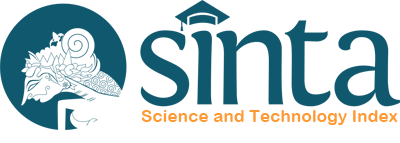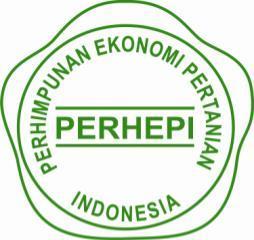Potensi Cendawan Antagonis Trichoderma Viride Isolat Bogor sebagai Agensi Pengendalian Hayati Penyakit Antraknosa Tanaman Cabai Merah
Antagonist Potential of Bogor Isolate of Trichoderma viride as a Biological Control Agent on Anthracnose Disease of Red Chilli
DOI:
https://doi.org/10.51852/jaa.v8i1.731Keywords:
antracnose, Colletotrichum capsici, intensityAbstract
Anthracnose disease caused by Colletottrichum capsici on chili plants that can damage yields by up to 80%. Control with fungicides has not been able to provide maximum results, because the fungus can move due to water splashes, especially in the rainy season. The use of antagonistic fungi against Colletotrichum capsici. has been widely published but is still limited to laboratory and greenhouse scales. This study aims to analyze the potential of Bogor isolate Trichoderma viride antagonist fungus against the fungus C. capsici through in-vitro study in the laboratory, screen houses, and field conditions. The experiment was structured using Complete Randomized Design (CRD) with parameters that measured respectively the antagonistic ability, and the percentage of attack by C. capsici and the severity of anthracnose disease on chili plants were both tested in screen house condition. Bogor Isolate T. viride has potential as a biological control agent for chili plants. This is proven by the ability to suppress the growth of C. capsici by 71% in vitro. The use of the fungus T. viride with a concentration of 7x106 conidia/ml (full strength) can suppress the development of anthracnose by 59 to 87% under screen house conditions. In other words, the pathogenicity of capsici in red chili plants shows a severity level of 13 to 41%.
References
Alamsyah AZ, Ali M. 2019. Uji daya antagonis beberapa isolate jamur endofit cabai merah terhadap Colletothricum capsica dan kemampuannya untuk mengendalikan penyakit antraknosa pada cabai merah. Jurnal Agroteknologi Tropika. 8 (1): 1–9.
Alfia AD, Haryadi NT. 2022. Pengujian konsentrasi biofungisida cair berbahan aktif trichoderma sp. dalam pengendalian penyakit antraknosa (Colletotrichum sp.) pada cabai di lapang. Berkala Ilmiah Pertanian. 5 (2): 58–64. DOI: https://doi.org/10.19184/bip.v5i2.28858
Afrizal, Marlina, Susanti F. 2013. Kemampuan antagonis Trcihoderma sp. terhadap beberapa jamur patogen in vitro. J. Floratek 8: 45-51. Available at http//:jurnal.unsyiah.ac.id/floratex/oai
Arofahsari DN. 2015. Viabilitas dan efektivitas biofungisida berbahan aktif Trichoderma harzanium untuk mengendalikan penyakit Rhizoctonia pada tanaman kedelai [skripsi]. Jember: Program Studi Agroteknologi Fakultas Pertanian Universitas Jember. Available at https//:repository.unej.ac.id
Dharmaputra OS, Ambarwati S, Retnowati I, Nurfadila N. 2015. Mikobiota pada buah cabai untuk pengendalian hayati Colletotrichum capsica. Jurnal Fitopatologi Indonesia. 11 (5): 150–158. DOI: http://doi.org/10.14692/jfi.11.5.150.
Herwidyarti KH, Ratih S., Sembodo DRJ. 2013. Keparahan penyakit antraknosa pada cabai. J. Agrotek. 1 (1): 102-106. DOI: http://dx.doi.org/10.23960/
Khairul I, Montong VB, Ratulangi MM. 2017. Uji antagonisme T. viride terhadap colletotrichum capsici penyebab penyakit antraknosa pada cabai keriting secara in vitro. Program Studi Agroekoteknologi, Jurusan Hama dan Penyakit Fakultas Pertanian, Universitas Samratulangi.
Kumar S, Singh V, Garg R. 2015. Cultural and morphological variability in Colletotrichum capsici causing anthracnose disease. Int J Curr Microbiol App Sci. 4 (2): 243–250.
Lubis JI, Yusriadi, Rizali A. 2018. Uji daya hambat Trichoderma spp. isolat kabupaten kapuas kalimantan tengah terhadap Colletotrichum spp. pada cabai. JTAM Agrotek View. 1(3).
Muliani Y., Krestini E., A. Anwar A. 2019. Uji antagonis agensia hayati Trichoderma spp. terhadap Colletotricum capsici Sydow penyebab penyakit antraknosa pada tanaman cabai rawit Capsicum frustescens L. Agroscript 1(1): 41 -50.
Nindya NS. 2018. Uji efektifitas metode aplikasi jamur antagonis T. viride terhadap penyakit antraknosa (Colletotrichum capsica) pada tanaman cabai (Capsicum annuum). Fakultas Pertanian, Universitas Negeri Gorontalo. Skripsi.
Nurhidayati S., A. Majid A., Mihardjo PA. 2015. Pemanfaatan biofungisida cair berbahan aktif T. viride untuk mengendalikan penyakit antraknosa (Colletotrichum sp.).
Purnomo H. 2010. Pengantar Pengendalian Hayati. Yogyakarta: CV Andi.
Putranto WA, Nugroho RA, Hardiyanta PS, Cahyaningrum DC. 2021. Are Trichoderma atroviride and Trichoderma harzianum effective to control Fusarium associated with tomato wilt? Microbiology Indonesia. 15 (3): 2–2.
Rohana I. 1998. Efektifitas penggunaan Trichoderma harzianum dan fungisida mankozeb untuk pengendalian rhizoctonia solani penyebab penyakit lodoh pada Acacia mangium [skripsi]. Bogor: Institut Pertanian Bogor.
Sanothan A, Montong VB, Lengkong M. 2023. Uji antagonis jamur Trichoderma sp. terhadap penyakit antraknosa Colletotrichum sp. pada tanaman cabai keriting Capsicum annuum L. di Laboratorium. JURNAL ENFIT: Entomologi dan Fitopatologi. 3 (1): 15–23.
Saxena A, Raghuwanshi R, Gupta VK, Singh HB. 2016. Chilli anthracnose: The epidemiology and management chilli anthracnose: the epidemiology and management. Frontiers in Microbiology. 7: 1–18. doi: 10.3389/fmicb.2016.01527.
Sriyanti NLG, Dewa NS, Ketut S. 2015. Uji keefektifan rizobakteri dalam menghambat pertumbuhan jamur Colletotrichum sp. penyebab antraknosa pada cabai merah (Capsicum annuum L.). Agroteknologi Tropika. 4 (1): 53–64.
Sukamto S. 2003. Pengendalian secara hayati penyakit busuk buah kakao dengan jamur antagonis Trichoderma harzianum. Prosiding Kongres XVII dan Seminar Ilmiah Nasional, Tanggal 6-8 Agustus 2003. Universitas Padjadjaran. Bandung. Hal:134–13.
Sulandari. 2004. Kajian biologi, serologi, dan analisis sidik jari DNA Virus penyebab penyakit daun keriting pada cabai [disertasi]. Bogor: Institut Pertanian Bogor.
Supriati LRB, Mulyani, Lambang Y 2010. Kemampuan antagonisme beberapa isolate T. viride indigenous terhadap Sclerotium rolfsii secara in vitro. J. Agroscientic. 17 (3): 119–122.
Than PP, Prihastuti H, Phoulivong S. 2008. Chilli anthracnose disease caused by Colletotrichum species journal of Zheijiang University Science B. 9 (10): 764–778. doi: 10.1631/jzus. B0860007.
Widyastuti SM. 2007. Peran Trichoderma spp. dalam Revitalisasi Kehutanan di Indonesia. Yogyakarta: Gajah Mada University Press


1.png)









